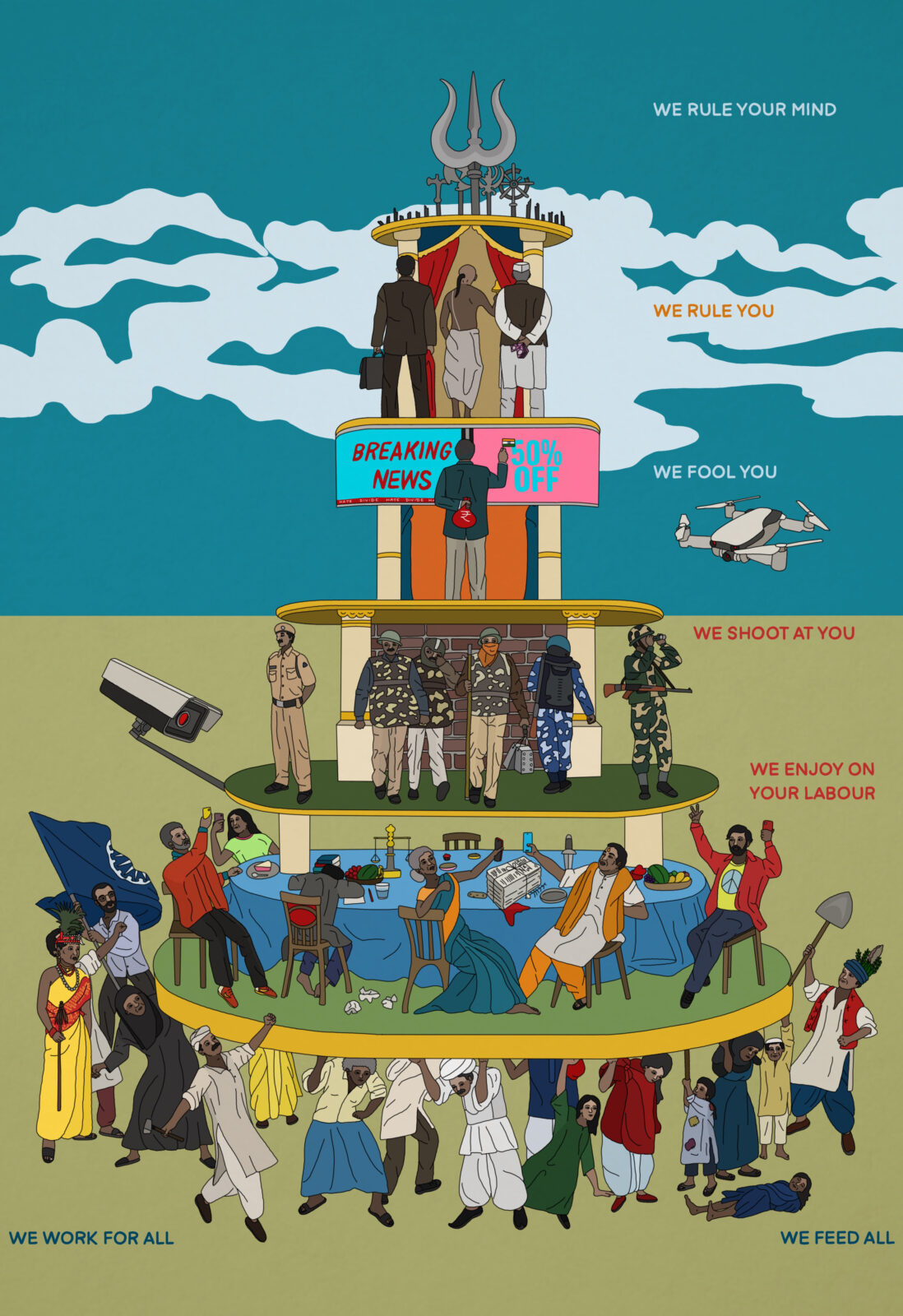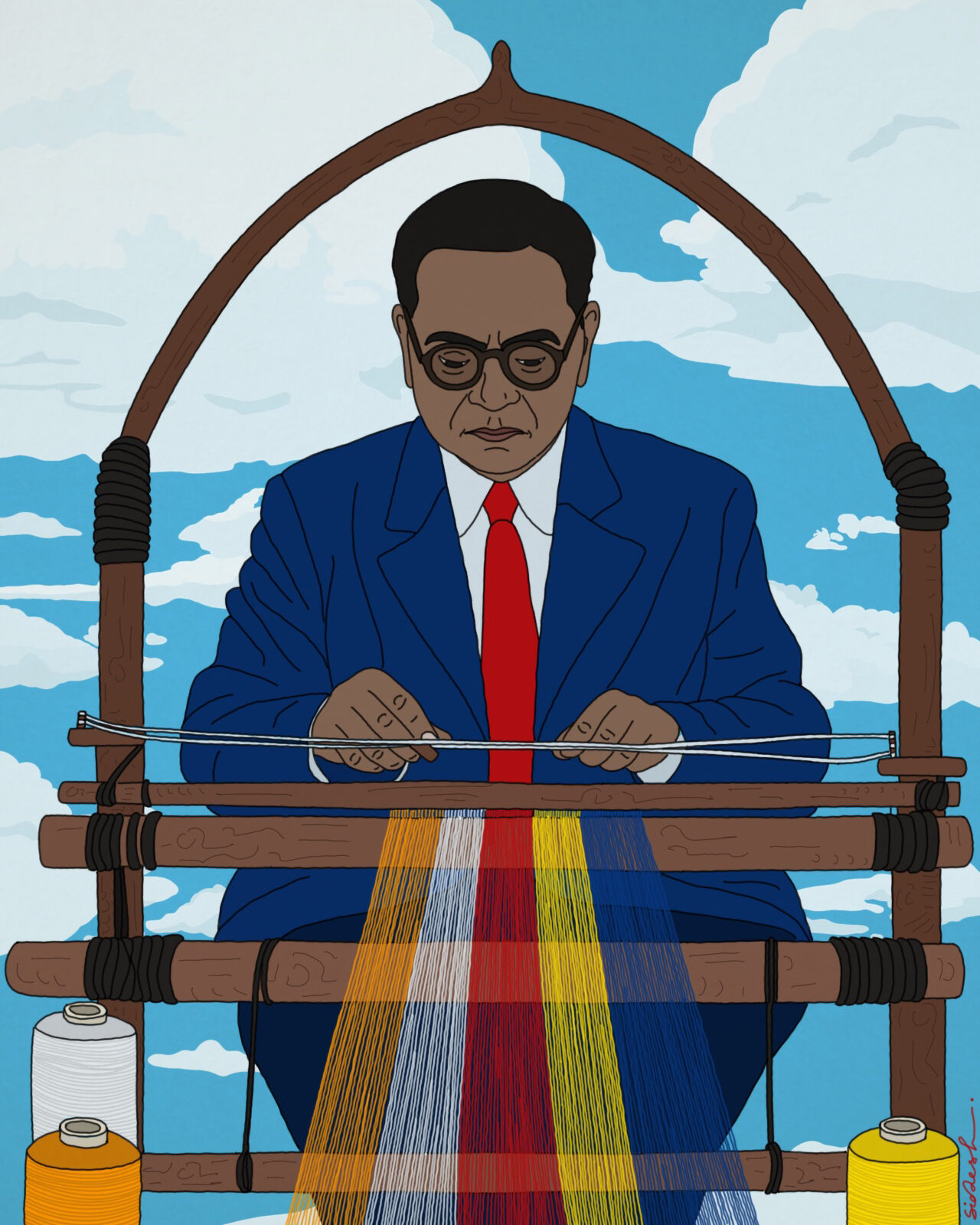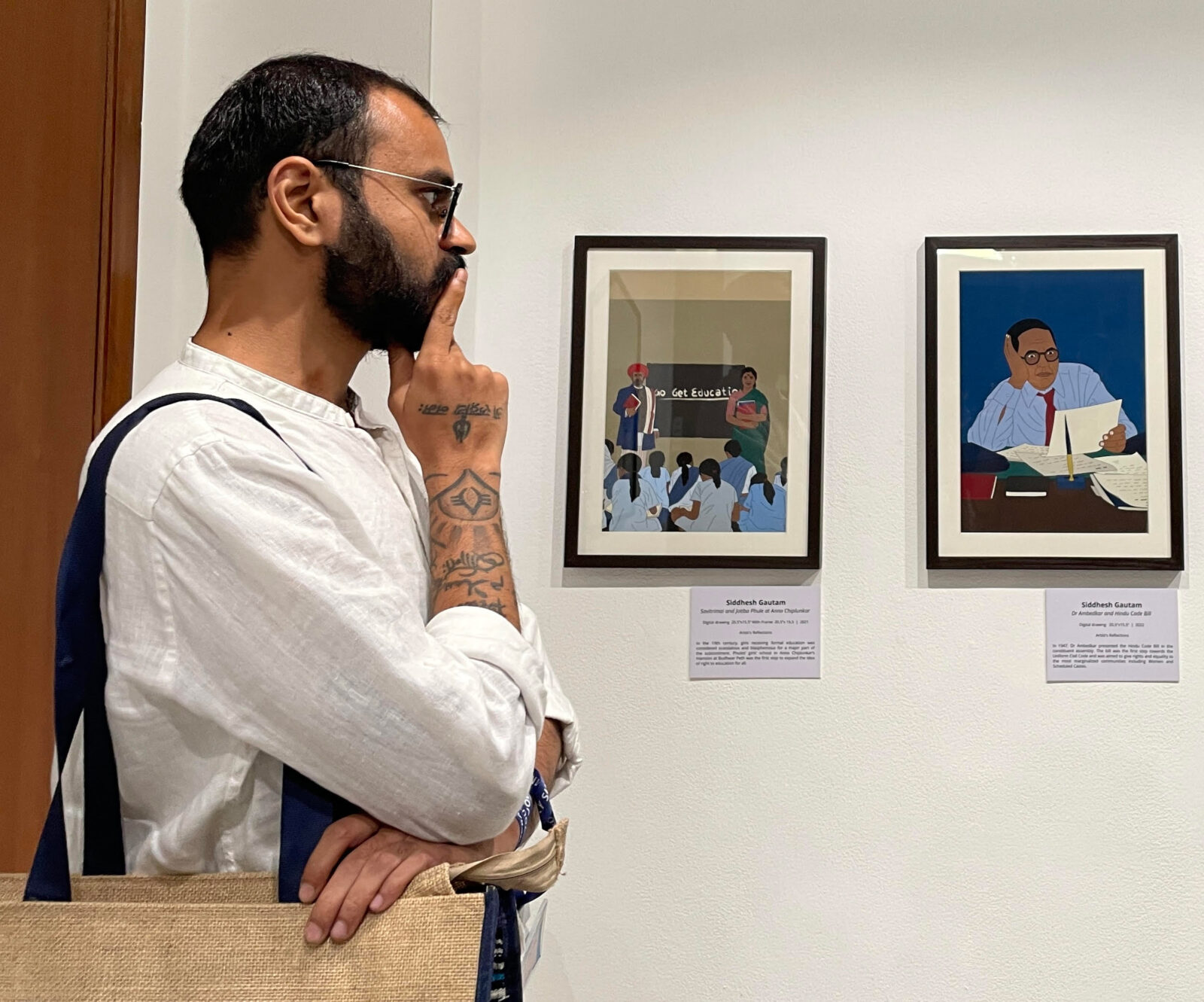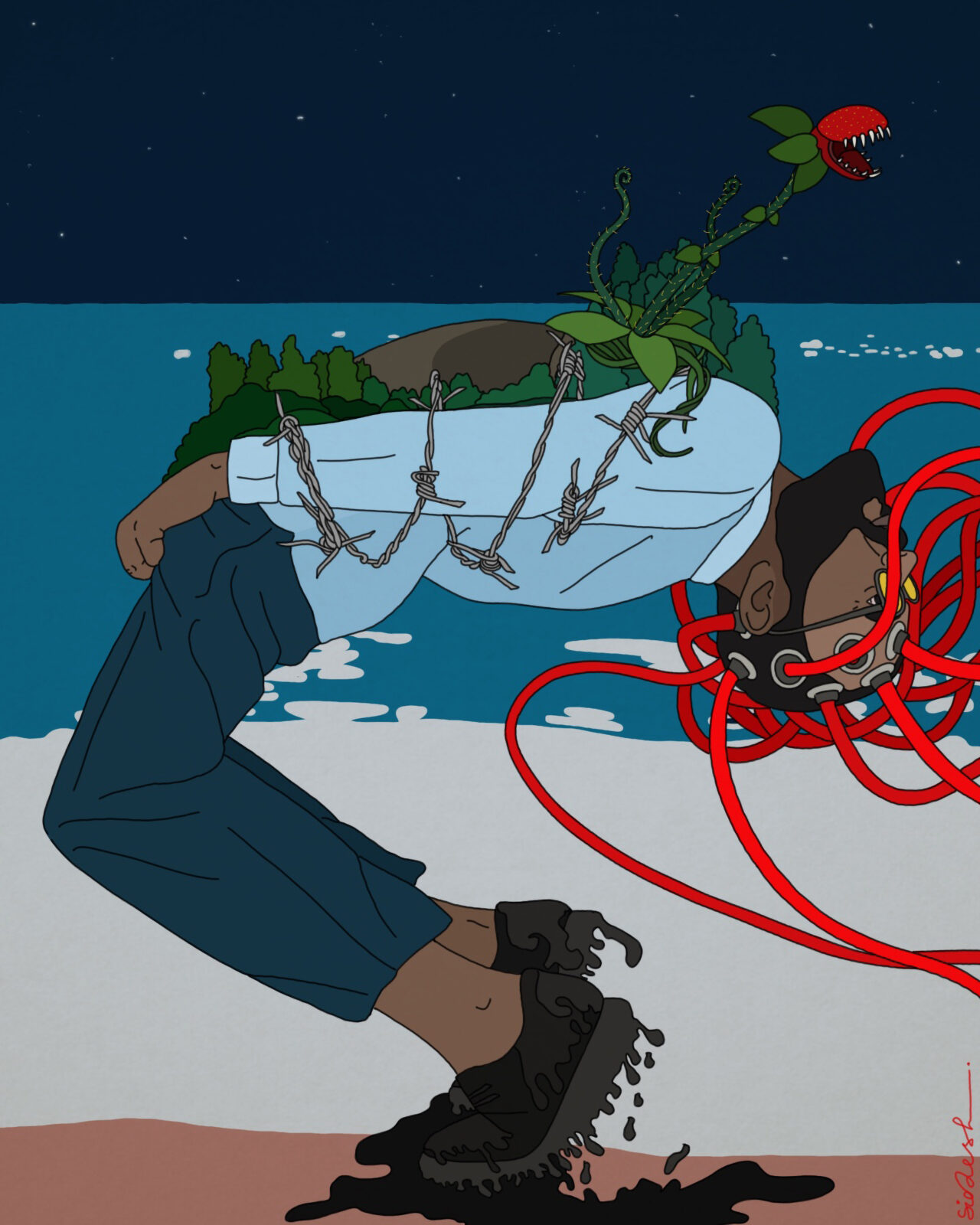
Siddhesh Gautam; Art Side of Ambedkarism; 2018; courtesy of the artist

Siddhesh Gautam; Art Side of Ambedkarism; 2018; courtesy of the artist
Making art in a world that denies your right to beauty is not just resistance—it is reclamation
There’s something deeply unsettling about the way we are taught to see art, as if it floats above history, above labor, above the body. Growing up in India, I seldom heard the word “art” spoken in my house. But I saw it everywhere. In the way my grandmother created products from waste. In the way she and her friends stitched stories into old sarees to make quilts, curtains, television covers. In the way my grandfather bound books. In the way my family made shoes, painted rickshaws and walls. In the way hands—brown, cracked, tired—carved, built, painted, wove.
But those things were never called “art.” They were chores. Culture. Utility. Survival. They were “craft.” Not even design.
And then I entered art spaces. Studied design. And everything flipped.
I realized very early that art wasn’t just about what was made. It was about who got to be called an artist.
In those clean, white galleries and halls, I saw brushstrokes celebrated as genius because they were conceptually “free.” I saw lifeless installations hung on walls and read essays calling them “radical.” I saw names, biographies, theories, and theatrics. But I did not see the people. My people. I did not see the Dalit women who embroidered resistance into bedsheets. I did not see the Dalit men who carved temples but weren’t allowed to enter them. I did not see the Adivasi elders whose tattoos held entire cosmologies. I realized very early that art wasn’t just about what was made. It was about who got to be called an artist.
Let me explain.
The caste system, a rigid social order that has governed South Asian society for over two millennia, is one of the oldest and most brutal forms of systemic inequality. It assigns people their occupation, status, and even spiritual worth based on birth. Dalits, once derogatorily called “untouchables,” have been forced into generations of dehumanized labor, denied access to education, dignity, and temples. Adivasis, or Indigenous communities of India, have been similarly marginalized, their lands grabbed and their cultural knowledge commodified or erased.
The binary between art and craft is not just aesthetic. It is not innocent. It is sexist. It is casteist. It is racist. It is colonial. It is violent.

Siddhesh Gautam; Pyramid of Religious Caste Capitalism in India; 2024; courtesy of the artist
In the Indian context, this division was already present throughout our own history and colonization reinforced it. British colonial administrators, obsessed with categorization, separated “high” fine arts from “decorative” or “ethnic” crafts. But this was only possible because the caste system had already laid the foundation for such hierarchies. Indian Brahminical administration was similarly obsessed with “purity.” The “high” and “pure” in the Indian subcontinent cemented this division even more. Caste has always dictated who creates, who theorizes, who touches, and who is touched by culture.
As a Dalit, I come from a community historically pushed out of temples, schools, and galleries. Our labor was needed. Our bodies were not. And so even when we built things—sculptures, icons, shrines—we remained unnamed. We remained unarchived. We remained impure. Our creativity was functional, not philosophical. Beautiful, but never brilliant.
The truth is that art for art’s sake is a luxury. A lie, almost. To create without survival at stake is a rare privilege, one that caste, class, gender, and race have always controlled. When an upper caste man or a white man paints an abstract canvas, it is art. When a Dalit woman paints on a canvas of her choice, it is folklore. When an upper-class white curator installs bricks in a white room, it is conceptual. When some workers build a sculpture of their leader in a ghetto, it is labor. This isn’t about medium—it’s about power.

Siddhesh Gautam; Dr. Ambedkar Weaving Buddhist Panchsheel Flag; 2025; courtesy of the artist
And this power is also deeply gendered.
The art-craft divide is a gendered wound. So many practices done by women— embroidery, weaving, stitching, patterning—are dismissed as feminine, domestic, decorative. They are rarely theorized, rarely signed, rarely paid. But they are repositories of resistance. Memory. Design. Thought. Women across castes and continents have always created, but their creations were folded into routine, not recognized as radical.
The grandmother who patched together scraps of fabric to make a warm quilt wasn’t just making a product, she was keeping a child alive. The Adivasi woman who tattooed myths onto her skin wasn’t being “tribal,” she was writing history. But the language of fine art has never had room for them. Because it was never meant for them. It was built to be selective. To protect its white walls. To deny touch.
To dismantle the art–craft binary is to unlearn everything we’ve been told about value.
Sometimes I think about how the first artworks humans ever made—cave paintings, handprints, carvings—were born not in galleries but in dark, cold shelters and in open grounds and forests. They were not decorations. They were not restrictive. They were survival. Communication. Community. They were art and craft and culture and science all at once. Somewhere along the way, the modern world began to separate these things. Cutting art off from life, thought off from hand, and aesthetics off from struggle.
Even in our own history, we see how visual traditions like Warli, Gond, Madhubani, Bhil, and Chittara—often sustained by women, by Indigenous and marginalized communities—are rarely included in the grand narratives of Indian art. They are boxed as “folk,” “ethnic,” or “tribal,” even when they are deeply theoretical, deeply radical, deeply modern. Because acknowledging them would mean acknowledging the intellect and aesthetics of people long kept outside institutions. It would mean letting go of the gate.
But how many more doors must we knock on to be seen?

Siddesh Gautam; photo courtesy of the artist
I don’t want to be invited into a gallery just to perform my pain. I don’t want a seat at the table that was built by erasing my ancestors. I want to build new tables. New spaces. New languages.
To dismantle the art–craft binary is to unlearn everything we’ve been told about value. It is to understand that labor is not the opposite of creativity. That struggle does not disqualify beauty. That the most powerful acts of creation often happen in spaces not considered sacred—kitchens, streets, fields, beds, ghettos/bastis.
I have learned more about art from a Dalit shrine on the roadside than from many museums. I have seen more imagination in the hands of people who are women, queer, or from marginalized communities than in entire catalogs of contemporary abstract art. That’s not a romanticization. It’s a reorientation.
As an artist, I carry with me not just my tools but my history. I carry the silence of those whose work was never signed. I carry the weight of a question: who gets to be remembered?
This binary between art and craft has been used to separate not just materials but people. To say: this is genius, that is labor. This is intellectual, that is ancestral. This is worth money, that is worth forgetting.
But I refuse to forget.
I refuse to accept a world where the painter in Paris is called a visionary and the tattooist in Bangkok is called traditional. I refuse to accept that an oil painting of a pot is art, but the pot itself is not.

Siddhesh Gautam; Who Dictates What I Create; 2024; courtesy of the artist
Let us blur the lines. Let us rewrite the definitions.
A pot can be a cosmos. A quilt can be an archive. A tattoo can be a scripture. A shoe can be a protest.
Art does not begin at the gallery door. It begins in the body. In memory. In survival. And it continues wherever someone dares to create, despite being told they are not allowed to.
So I keep drawing. I keep remembering. I keep naming the unnamed.
Because to make art, in a world that denies your right to beauty, is not just resistance. It is reclamation.
And it is time to reclaim the history and the future.

Siddhesh Gautam is a Delhi-based, multidiscipline, mixed-media artist, designer, writer, poet, dreamer, storyteller, and an Ambedkarite. His work is currently focused on the visual documentation of the anti-caste movement, global warming, and gender equality. His work has been published by the BBC, The Guardian, The Wire, and The Hindu, among others. He has also worked with and given lectures and talks at various universities and colleges, including Stanford University, University of Washington, Oxford University, SOAS University of London, University of Vienna, and International Institute of Social Studies, Hague.
Get the latest news and stories from the Rubin, plus occasional information on how to support our work.